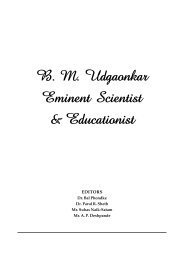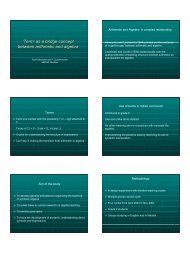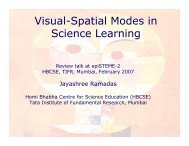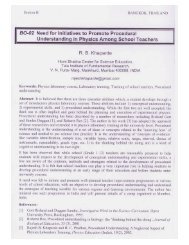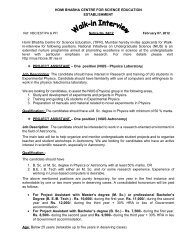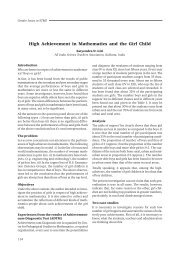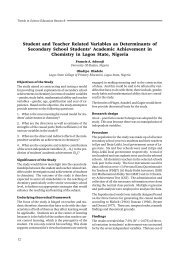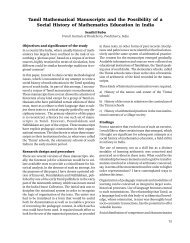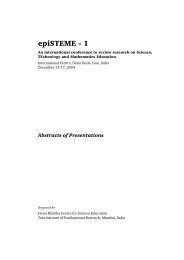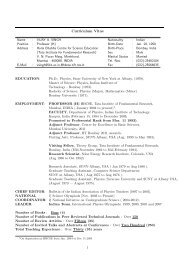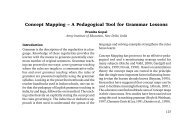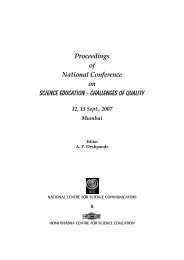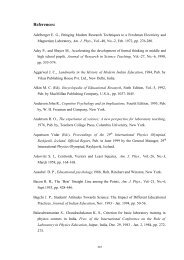Abstract(PDF) - Homi Bhabha Centre for Science Education
Abstract(PDF) - Homi Bhabha Centre for Science Education
Abstract(PDF) - Homi Bhabha Centre for Science Education
Create successful ePaper yourself
Turn your PDF publications into a flip-book with our unique Google optimized e-Paper software.
Knowledge RepresentationKnowledge Organizers of Cell BiologyMeena Kharatmal & Nagarjuna G.<strong>Homi</strong> <strong>Bhabha</strong> <strong>Centre</strong> <strong>for</strong> <strong>Science</strong> <strong>Education</strong>, TIFR, Mumbai, IndiaAs the scientific pursuit progresses, the number of technicalterms in sciences is always on the rise. However,the use of knowledge organizers, more or less, remainconstant. Knowledge organizers consist of (1) the typesof concepts (Metatypes) used in knowledge (2) types ofrelations used to relate the concepts (Relation types)and (3) logical connectors and quantifiers used to expressthe knowledge.Representing common sense knowledge using theseminimal knowledge organizers is highly challenging,and often impossible since generalizations of commonknowledge may not always work. However, much ofscientific knowledge uses a small subset of our naturallanguage since scientific language is highly conventionaland <strong>for</strong>mal. Our attempt is to represent alreadywell organized scientific knowledge using KnowledgeRepresentation (KR) methodology. The problem of representingknowledge of exact sciences like physics andmathematics is seemingly easier than not-so exact scienceslike biology. The ontology of biological sciencesis not as clear as other branches of science. In thiswork, we attempt to introduce our methodology <strong>for</strong>representing the knowledge of biological sciences. Thisexercise also helps us to explicate the structure of biologicalknowledge.How can this methodology help us in science education?In science education, we expect the students tolearn the concepts of science. According to a study conductedby us, students come across about 4000 conceptsin the domain of biology, (excluding the namesof all the species of plants and animals) upto highersecondary level of education (Thulasidas andNagarjuna, 2001). However, the knowledge organizersrequired to understand these terms are not onlyconstant but few in number. Our hypothesis is: ifduring the course of science education students aretrained to think and study the world using knowledgeorganizers, meaningful learning, in contrast to rotelearning, as explicated by Ausubel (Ausubel et. al.,1978), takes place. With this understanding when weexplored <strong>for</strong> a set of required knowledge organizers<strong>for</strong> science (or <strong>for</strong> the domain of biology) from theliterature, we could not obtain any such set readilyavailable. This indicates that there is a need to developan authentic set of knowledge organizers <strong>for</strong> usein science education. Our research objective is to fillthis gap.Representing anatomical details is more or less straight<strong>for</strong>ward,since this knowledge can mostly be representedusing class inclusion, spatial inclusion, partwholerelations (Winston et. al., 1987). But much ofthe core biological knowledge is contained in physiology,molecular biology, developmental biology, ecology,etc. Representing this knowledge in KR terms isoften challenging. Based on our earlier analysis ofbiological terms, most significant knowledge of thisfield is expressed in terms of concepts that describeprocesses, states, or stages, and cycles. We make anattempt to explicate the general structure of these sciencesto arrive at a definite KR <strong>for</strong> physiology. Sincecell biology is a good representative <strong>for</strong> much of biology,we chose this area.Many educational researchers have found it useful toadopt a network representation <strong>for</strong>mat <strong>for</strong> explicitlyrepresenting knowledge structure. There exists variousmethods to represent knowledge such as—conceptmap, knowledge Vee, Concept Circle Diagrams,SemNet, Conceptual Graphs. After analyzing the conceptmapping methodology, we identified several problemson the basis of our knowledge organizers. Theseare discussed in an article, Towards Principled Approachof Concept Mapping (Nagarjuna and Kharatmal, UnpublishedPaper). We find the conceptual graphs approachby Sowa (Sowa, 1984) is highly instructive andwe plan to make use of this technique <strong>for</strong> representingscientific knowledge. Based on our understanding, wedeveloped a model of KR and an application that canbe used to undertake the task. The software applicationcalled GNOWSYS (Gnowledge Networking andOrganizing SYStem) (see URL in ref.) is developedwhich helps to construct the set of organizers of scientificknowledge. An introduction to the KnowledgeOrganization (KO) model of this application will bediscussed. In this work, we shall describe the methodologyfollowed to construct the set of knowledge organizersusing GNOWSYS <strong>for</strong> science education andillustrate the method <strong>for</strong> the domain of cell biology.We shall indicate how this methodology can be used inunderstanding the structure of knowledge, measuringcognitive significance of concepts, generality-specificity124
Knowledge Representationindex of concepts, defining learning paths based oncognitive dependency relations, comparison of noviceexpert’scognitive structures, etc.Referenceshttp: //www.gnowledge.org/Data/ObjectType/GNOWSYS/Ausubel, D., Novak, J., and Hanesian, H. (1978). CognitivePhyschology: A Cognitive View. Holt, Rinehartand Winston, New York.Carey, S. (1986). Conceptual change and science education.American Psychologist, 41(10): 1123–1130.Fisher, K. and Kibby, M., eds. (1996). Knowledge Acquisition,Organization, and Use in Biology. Springer-Verlag, Germany.Fisher, K., Wandersee, J., and Moody, D. (2000). MappingBiology Knowledge. Kluwer Academic Publishers,The Netherlands.Mintzes, J., Wandersee, J., and Novak, J., eds. (1998).Teaching <strong>Science</strong> <strong>for</strong> Understanding — A HumanConsctructivist View. Academic Press, USA.Mintzes, J., Wandersee, J., and Novak, J., eds. (2000).Assessing <strong>Science</strong> Understanding – A HumanConstructivist View. Academic Press, USA.Nagarjuna, G. and Kharatmal, M. (UnpublishedPaper). Towards a principled approach of concept mapping.Novak, J. and Gowin, D. B. (1984). Learning How toLearn. Cambridge University Press, UK.Sowa, J. (1984). Conceptual Structures: In<strong>for</strong>mationProcessing in Mind and Machine. Addison-Wesley PublishingCompany, USA.Sowa, J. (2003). Knowledge Representation: Logical,Philosophical and Computational Foundations. Brooks/Cole, USA.Thulasidas, S. and Nagarjuna, G. (2001). A methodology<strong>for</strong> the analysis of biological knowledge base. InAgarkar, S. C. and Lale, V. D., eds., CASTME-UNESCO-HBCSE International Conference on <strong>Science</strong>, Technologyand Mathematics <strong>Education</strong> <strong>for</strong> Human Development,volume 1, pages 149–155. HBCSE, Mumbai,India.Winston, M., Chaffin, R., and Herrman, D. (1987). Ataxonomy of part-whole relations. Cognitive <strong>Science</strong>,11: 417–444.



